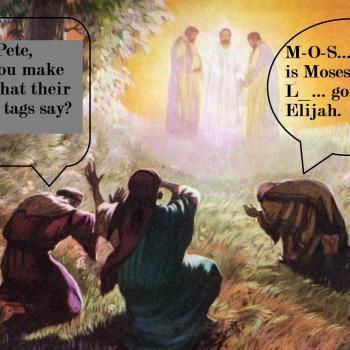I’m worried that this post will be flagged on social media because of the title. It is not at all explicit in its content, although it does indeed mention people being naked. Two different people, although they may be connected. The reason I am blogging about this is to see what others think. As you probably know, I am writing a book that introduces the key information and terminology for New Testament studies to a general audience. In essence it is “things that scholars know about the New Testament that you should too if you have even the slightest interest in it.”
As I was writing about clothing and working on a section about the lack thereof in a couple of stories, I saw a possible connection with what I have written previously about the ending of Mark’s Gospel. I think that the story that is being told in Mark’s Gospel originally continued beyond the abrupt ending in our earliest manuscripts. Early damage is a likely scenario, but even if the author stopped writing at that point for some reason, they show they knew a story that continued beyond Mark 16:8. I don’t think that John 21 is Mark’s missing ending, but I think it tells a story similar and related to what followed in Mark. The women said nothing to anyone. The male apostles had fled home to Galilee. They went back to their work and while fishing, Jesus appeared to them.
What I just noticed more recently is the nudity that connects the two stories. In Mark 14 one of the male disciples flees leaving behind the linen that he was wearing. In John 21 Peter has no outer garment on (and perhaps nothing at all, although that is unlikely, despite the text saying he was “naked”) and when he sees Jesus, he throws his clothes on and jumps in the water. In Mark the person is so terrified that they are willing to be left naked in their haste to abandon Jesus and save their own (now all too visible) skin. In John Peter’s enthusiasm to be reunited to Jesus leads him to throw on clothing when someone who was thinking clearly would refrain from doing so. There seems to be a contrast between the almost comical nakedness of the one who inappropriately forsakes Jesus, and the actually quite comical clothedness of the one who is determined to let nothing come between him and Jesus. The story in John 21 then reaches its conclusion with Jesus restoring Peter after his denial and emphasizing that he will follow Jesus on the way of the cross leading to his own death, with a particular emphasis on the fact that in the future Jesus is predicting Peter will no longer dress himself nor be able to go where he decided for himself to go.
Just as an encounter between Jesus and the disciples at the seashore forms a bookend (inclusio) between the beginning and ending of Mark’s story according to this hypothesis, clothing and a linen sheet connect failure and success in discipleship to Jesus the crucified. A frightened disciple leaves a linen sheet behind so as not to end up wrapped in one as Jesus would soon. Peter has a little more courage but then denies Jesus. He clothes himself and finds restoration, but ultimately he will not get to choose his clothing in the end, perhaps alluding to Peter’s own future burial shroud and the fact that he might well not get one.
I’m interested to hear what readers think, both those who might already have been inclined to agree with my suggestion about the ending of Mark, as well as those who up until now had been detractors. Do these connections seem plausible as we think about the story that might have been in Mark’s original ending?
See my article in The Bible and Interpretation “Mark’s Missing Ending” for more of my thoughts on that topic, as well as previous posts on this blog:












